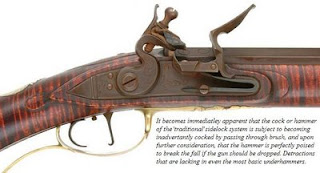I will now try to answer that nagging question in the minds of many muzzleloaders, “Why would anyone in their right mind want a rifle with the hammer on the bottom?!”
Most of us are well aware of the most obvious advantage of the underhammer system, that being its ambidextrous nature that allows our left-handed brethren equal opportunity to enjoy the many other advantages of this unique firearm genre. There are several other features, though, that many underhammer designs share, which, when combined with good engineering and top-quality craftsmanship, have become the most sought of the underhammers, hence, the most valuable to collectors and shooters alike.

Obviously, mounting the hammer below the receiver, where it swings upward to the barrel, offers several logical advantages over the side-mounted hammer. The shooter’s view of both the sights and the target is not interrupted by the distraction of a hammer protruding into the shooter’s field of view. Likewise, the percussion underhammer system keeps the flash and the shrapnel of the cap from the eye and provides a greater margin of protection to the face. It was, after all, the distracting flash of powder in the priming pan that inspired the first flint underhammer designs by Germanic gunmakers back in the 18th century (that's the 1700s for those who didn't pay attention in History class).
Clicking in the center of the photo above will enlarge it to provide a better idea of just how much flame and distraction is created by the flintlock. Remember, that when firing a flintlock rifle the flare seen here is much closer to the shooter's face than with a pistol held at arms length. By the way it is at this precise moment that you're supposed to be focusing on breathing, sight alignment, and trigger squeeze...
Yeah, right. They weren't nicknamed "flinchlocks" for nothing.
Clicking the "Back" arrow at the top left of the screen will return you to the text.
Despite its obviously logical advantages, many who have actually shot some underhammer rifles dislike them because most designs are notorious for spitting cap shrapnel into the shooter’s wrist, while some pistols pepper the fingers of the shooting hand. A simple solution is to utilize a musket nipple and caps. Musket caps, being constructed of thicker metal, do not fragment upon firing as #11 caps are designed to do. Musket caps are also much "hotter" than wimpy #11 caps and can make a considerable difference in the performance of the firearm.
True, not all underhammers can be corrected so simply. Other methods of overcoming the spitting require fitting flash shields or modifying hammer faces or worse. Luckily, however, some underhammers were designed with this situation in mind and don’t have the nasty habit of spitting cap fragments.
Mounting the hammer below the barrel further allows placement of the nipple directly into the barrel without need for a separate drum, bolster or snail. So arranged, the cap is closer to the powder charge and its flash isn't diminished in speed or intensity by having to negotiate corners, but instead, is projected directly into the powder charge resulting in more instantaneous ignition and improved accuracy.
One other great advantage of the bottom-mounted hammer is that if the firearm is dropped, it is far less likely to fall directly upon the hammer and accidentally fire the piece than if the hammer is protruding from the top of the piece, as is the case with side mounted hammers - whether in rifles or pistols.
And speaking of hammers and safety issues and all that liability stuff, one will find that some underhammer pistols and rifles of old, yes, and some new one's, too, are not equipped with a trigger guard nor a half-cock notch. If you come upon one of these designs, be sure to exercise extra caution in handling and shooting them.
The bottom-mounted hammer also limits the possibility of the hammer being inadvertently cocked and/or having the cap flicked from the nipple, or the flintlock's frizzen being snapped open with loss of priming powder, all by the snag of a branch while stalking through thick cover. All events that I have had unpleasant personal experiences with many years ago while carrying various side-hammer rifles.

Most underhammer designs feature a trigger that is in direct engagement with its hammer, thus eliminating the need for extra parts such as the sear, tumbler, fly, and bridle, as well as their attendant small screws and spring. A correctly designed hammer and trigger directly engaged, as in better underhammer designs, also eliminates the need of a set trigger mechanism to achieve a crisp pull of the trigger, although there are a few examples of older underhammer target rifles that were so equipped.
So, there you have it. While different makers have incorporated other, perhaps less obvious features, these are the primary advantages of the underhammer guns that we have come to admire so much.
Did I forget anything?
Randy, I hope I’m out from behind the bullseye, now.
.
I always thought underhammers were pretty cool, but I had no idea how cool they really are until reading this.
ReplyDeleteThanks.
Brad
I have an "N. Kendall Windsor VT Patent" marking on the ocatagonal barrel of my underhammer with 107 on the sight and the stock's brass end piece. I have gone to local gun shows and everybody is amazed at the excellent condition and the beautiful cherry colored stock and ramrod. I have been told by many collectors that it is valued from $1,000. to $2,500., but can not find it in any authoritive price guide or even an accurate description in Sharps. I can supply many pictures of the various parts. Collectors have blown in the barrel and other tests to verify that it is an exceptional piece. If anyone can help me with valuation please contact me at fla-usa@comcast.net I am posting this on March 5th 2011
ReplyDeleteRod